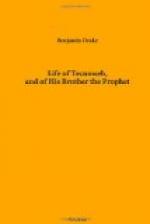At the period of its destruction, Piqua was quite populous. There was a rude log fort within its limits, surrounded by pickets. It was, however, sacked and burnt on the 8th of August, 1780, by an army of one thousand men from Kentucky, after a severe and well conducted battle with the Indians who inhabited it. All the improvements of the Indians, including more than two hundred acres of corn and other vegetables, then growing in their fields, were laid waste and destroyed. The town was never afterwards rebuilt by the Shawanoes. Its inhabitants removed to the Great Miami river, and erected another town which they called Piqua, after the one that had just been destroyed; and in defence of which they had fought with the skill and valor characteristic of their nation.[A]
[Footnote A: For this sketch of Piqua, the author is chiefly indebted to his venerable friend, Major James Galloway, of Xenia, Ohio.]
The birth of Tecumseh has been placed by some writers in the year 1771. Ruddell states that it occurred in 1768, three years earlier, and this, we think, is probably the true period. His early boyhood gave promise of the renown of his maturer years. After the death of his father, which occurred when he was in his sixth year, he was placed under the charge of his oldest brother, Cheeseekau, who taught him to hunt, led him to battle, and labored zealously to imbue his mind with a love for truth, generosity, and the practice of those cardinal Indian virtues, courage in battle and fortitude in suffering. From his boyhood, Tecumseh seems to have had a passion for war. His pastimes, like those of Napoleon, were generally in the sham-battle field. He was the leader of his companions in all their sports, and was accustomed to divide them into parties, one of which he always headed, for the purpose of fighting mimic battles, in which he usually distinguished himself by his activity, strength and skill.[A] His dexterity in the use of the bow and arrow exceeded that of all




